Are Spare Ribs Pork or Beef
A rose, is a rose, is a rose, according to Shakespeare. When it comes to ribs, though, there are many differences between types worth knowing. If you plan to be more than just a casual griller, this is seriously need-to-know information.
In a series of articles, we're identifying the different kinds of pork ribs available to you, comparing their pros and cons (if there are any cons to ribs!), and teaching you how to prepare and smoke them. Plus, we'll connect you with some of the absolute best recipes on the web for making mouth-watering, bone-sucking good ribs in your own backyard.
This time around, it's spare ribs versus St. Louis style ribs, two of the all-time greats. Which is which, and how can you tell? All the answers are below.
Contents (Jump to Topic)
- 1 Spare Ribs Overview
- 1.1 Where on the Pig They Come from
- 1.2 How Much Meat and Fat do They Contain?
- 1.3 Nutritional information Per 4oz (1/4 Pound)
- 1.4 Portion Size: How Many Spare Rib Ribs Per Person
- 1.5 How to Prepare Spare Ribs for Smoking
- 1.6 How to Cook Spare Ribs in a Smoker
- 1.7 Where to Buy Spare Ribs Online
- 2 St. Louis Ribs Overview
- 2.1 Nutritional information Per 4oz (1/4 Pound)
- 2.2 How to Trim Spare Ribs to Become St Louis Cut
- 2.3 Why Bother Cutting St Louis Style? What are the Benefits?
- 2.4 Where to Buy St Louis Ribs Online
- 3 Three Excellent Smoker Recipes for Spare or St. Louis Ribs from Around the Web
- 3.1 Sweet Honey Lime Smoked Ribs
- 3.2 Mesquite Smoked BBQ Pork Ribs
- 3.3 Smoked Mustard Crust Spare Ribs
- 4 There's Little More to Say
- 5 Final Thoughts
Spare Ribs Overview
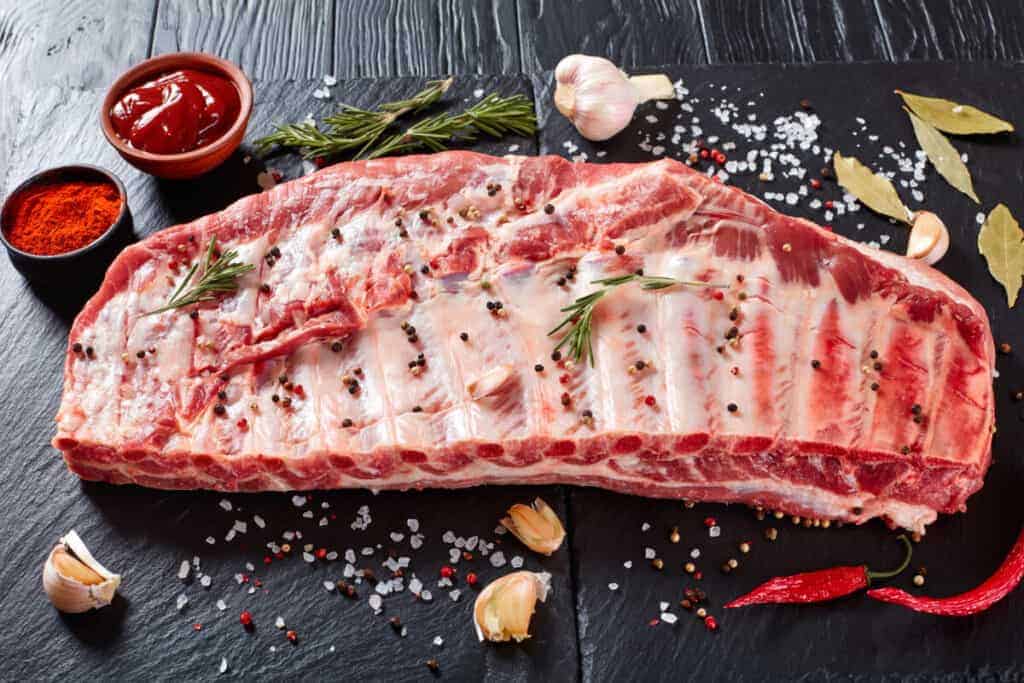
"It's important to note that we did not become rib masters overnight. It took time to learn the appropriate techniques. Tender, slow-cooked spare ribs require a certain amount of skill and experience." — Pat Neely
Well, that's why we're all here, right? To learn how to make incredible ribs. No, it won't happen the first time. But it will happen, and what a day that is!
Now, despite the big build-up in the introduction, it turns out spare ribs and St. Louis style ribs are basically the same thing. St. Louis ribs are, in fact, cut from the spares, so they share many characteristics.
From this information, we can conclude that a rack of spare ribs is larger than a rack of St. Louis. Incidentally, if you've seen or heard reference to "side ribs," it's just another term for spare ribs.
Spare ribs aren't the most tender cut of meat, being so far from the loin. But, that's where the magic of smoking comes in. Smoking them low 'n' slow makes them easy to eat and unleashes a ton of rich flavor.
Spare ribs are popular throughout most of the world, and you see a lot of them at ribfests and competitions.
Where on the Pig They Come from
Spare ribs are cut from the end portion of the rib cage, right down at the belly of the pig. They extend around the side of the pig and down to the breastbone, which the butcher removes.
They're long ribs, and they come to a ragged end of extra meat and cartilage. Plus, spare ribs sport a bonus flap of meat called the skirt. A typical rack of spare ribs totals 11 bones.
How Much Meat and Fat do They Contain?
As mentioned above, there is a lot of meat on spare ribs, making them an ideal choice for parties and large crowds. They're also blessed with a lot of fat. If fat doesn't seem to you like a blessing, remember that fat equals flavor when it comes to meat.
Nutritional information Per 4oz (1/4 Pound)
| Nutrition | Total Amount | % Daily Value (based on 2000 calories/day) |
|---|---|---|
| Calories | 320 | 16 |
| Total Fat | 26 g | 40% |
| Cholesterol | 85 mg | 28 |
| Sodium | 85 mg | 28 |
| Protein | 19 g | |
| Calcium | 4 | |
| Iron | 6 |
Portion Size: How Many Spare Rib Ribs Per Person
A rack of spare ribs is physically large, but there aren't a lot of bones. Plan on 4-5 bones per lucky person at your barbecue.
How to Prepare Spare Ribs for Smoking
Don't be tempted to put an untrimmed rack of spare ribs in your smoker. While there may be a sense of primal delight, a little prep goes a long way.
To prevent unwanted chunks of burnt crud, trim any big flaps and nodules of fat and random sinew. Don't worry, though — there will still be plenty of fat for flavor and juiciness.
More than likely, your spare ribs will come with a thin but shockingly resilient membrane attached to the bone side of the rack. Before you continue, this has got to go. Yes, you can cook with it in place, but you're just passing the job off to your guests, who will have to gnaw through it. Strip it away, and you'll also get deeper, more even penetration of smoke, rub, and sauce.
Begin with a sharp paring knife. Slip the blade between one of the outside bones and the membrane and, with short, careful strokes, begin separating the two. Mind you don't cut any meat off the ribs or your fingers. Soon, you'll have a flap of membrane large enough to get hold of with your hands. Grab it, and peel away the membrane, hopefully in a single sheet. Find more detailed instructions with images in our guide on how to remove the membrane from ribs.
If your recipe calls for marinade or brine, do it now. Allow several hours for liquids to soak in, or you may as well not bother. If you can leave it all night, that's usually ideal. Once that process is over, you can massage in your spice rub before moving to the smoker.
How to Cook Spare Ribs in a Smoker
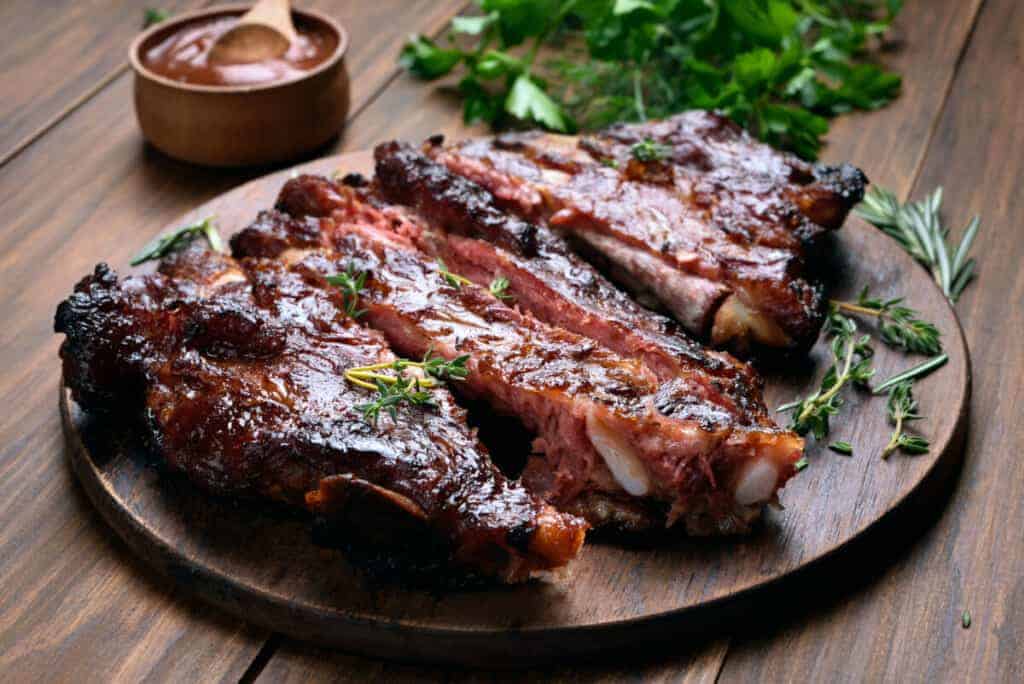
The preferred temperature for smoking spare ribs is 250 °F. Yes, that's the high-end of the low 'n' slow zone, but it's suitable for such thick and large ribs. It's still going to take the best part of the daylight hours to get the job done!
There are lots of wood choices available to the smoker, but not all them are suited to ribs. Most Midwestern and southern recipes will call for mesquite or hickory. Fans of sweet BBQ flavors will want to try cherry or applewood. Oak is fine, but it's a little too safe for our liking.
Next comes the old question: do I wrap my ribs or not? The answer to that is yes — probably.
It's preferred by most pitmasters and barbecuers as it helps prevent ribs from losing their moisture while locking in the flavor. You can opt not to wrap your ribs, but you may find them a little drier that way. Still, it's all a matter of personal preference.
If you're using the famous 3-2-1 method to smoke your spare ribs, you'll certainly wrap your ribs; it's the "2" part of the system. If you're not familiar with it, 3-2-1 works like this: smoke unwrapped at your target temperature for 3 hours, switch to wrapped for 2 hours, and then close it out with 1 hour unwrapped over higher heat. That's the perfect combination for smokiness, juiciness, and crispy bark.
Apply your sauce, if you've decided to use any, during the last 30 minutes of the session. You risk burning it any longer, which is easy to do because most BBQ sauces are sugar-based.
Cook your spare ribs until they reach an internal temperature of about 190 °F – 200 °F. You'll know it's about that time when you start seeing exposed bones as the meat contracts, the meat is probe tender, and if you pick up the ribs with tongs, it will bend and start to crack slightly.
Where to Buy Spare Ribs Online
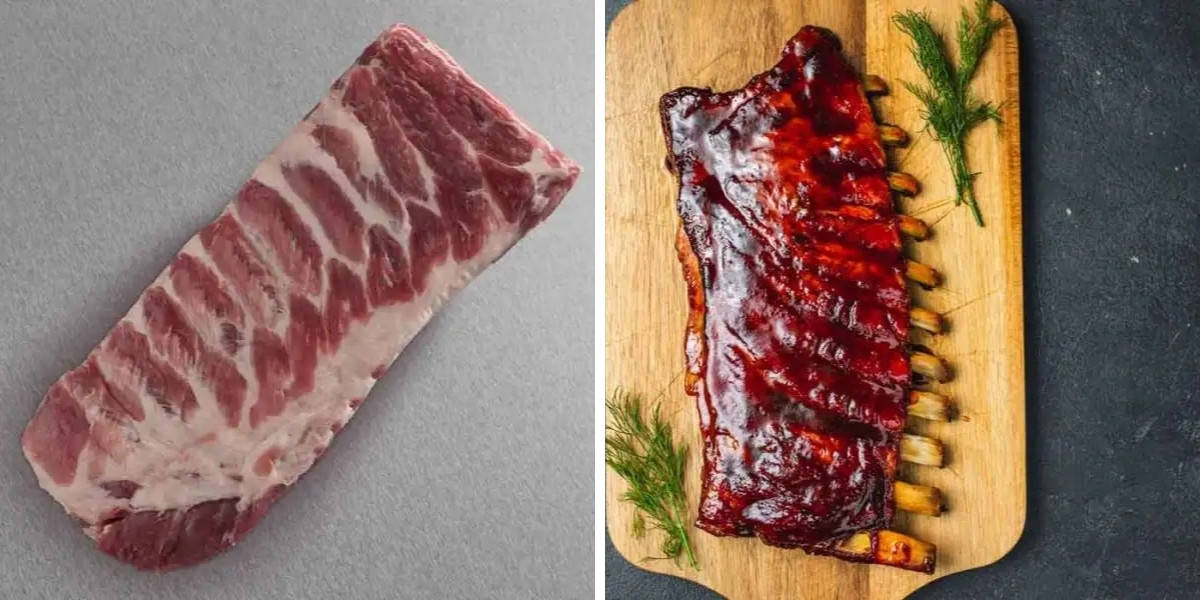
Snake River Farms' spare ribs are from purebred Berkshire, their American Kurobuta range.
They are all-natural and hormone-free, full-sized, with abundant flesh and superb marbling and intramuscular fat for a rich and fulfilling taste. Each rack weighs about 1.5 pounds on average.
Check Price on Snake River Farms
St. Louis Ribs Overview
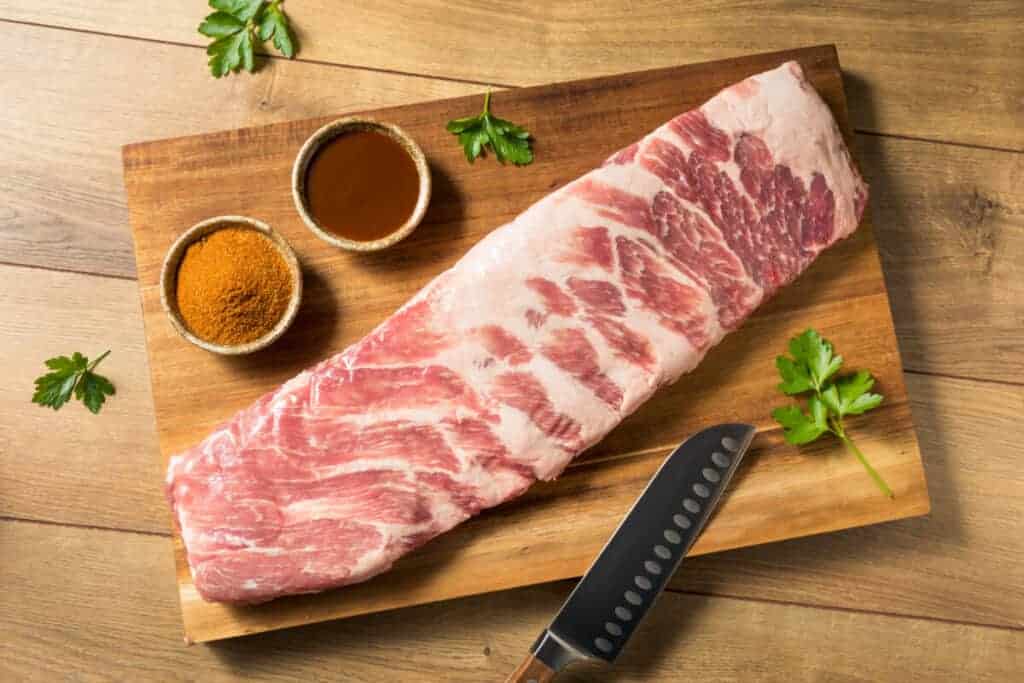
St. Louis style ribs are a neatly trimmed section of the larger spare ribs as touched on earlier. This cut came into existence sometime in the middle of the last century in -you guessed it- St. Louis, Missouri.
The butcher or meat packer removes the spare ribs' irregular ends, called the rib tips, and generally cleans the rack up into a good-looking rectangle of ribs. While they're shorter than spares, St. Louis style ribs are longer than baby back ribs.
Where you see St. Louis ribs frequently is on the competition circuit. Pitmasters love the even cooking, straight bones, and neat presentation of the rack.
Where you won't see St. Louis style ribs frequently is at the grocery store. If you want a rack, you'll either have to trim your own spares (and we'll tell you how a little further down) or get them from a proper butcher. You may need to custom order your rack.
Nutritional information Per 4oz (1/4 Pound)
| Nutrition | Total Amount | % Daily Value (based on 2000 calories/day) |
|---|---|---|
| Calories | 230 | 12 |
| Total Fat | 16 g | 24 |
| Cholesterol | 70 mg | 23 |
| Sodium | 90 mg | 4 |
| Protein | 17 g | |
| Calcium | 0 | |
| Iron | 4 |
How to Trim Spare Ribs to Become St Louis Cut
Time to let out your inner butcher! Here's how to cut down those spares into DIY St. Louis ribs:
- Get a long, sharp knife you know can cut through cartilage and sinew.
- Turn the rack bone-side down and place it on a cutting board. Remove the narrow, pointed end of the rack. The ribs should now be roughly rectangular in shape across the ends and one side.
- Flip the rack over and find the flap of meat called the skirt. (It's pretty easy to locate!) Cut this off and set aside; there's good meat here, so you might want to cook it separately.
- Trim away any other obvious bits of fat and gristle. You want your rack to be as evenly shaped as possible.
- Remove the membrane as you would with a rack of spare ribs. We've described this process up above, in case you missed it.
- Find where the ribs end inside the meat. Use this line as a guide for cutting away the meat that extends past the end of the ribs. You should now have a fully rectangular rack of St. Louis style ribs.
Don't discard the ends you cut off in the last step! These are called "rib tips", and they're fun to cook and eat on their own.
Why Bother Cutting St Louis Style? What are the Benefits?
So, if St. Louis style ribs are just spares trimmed a certain way, why go through the effort? Here are several good reasons.
- They just look better on the plate. If you think the presentation is part of the dining experience, you'll appreciate how appealing St. Louis ribs look, especially in comparison to the full spare.
- On a technical note, the uniform shape of St. Louis style allows them to cook more evenly. You'll get perfect doneness end-to-end and all the way through.
- They're much easier to eat because you've removed the extra bone and connective tissue found at the rib tips.
Where to Buy St Louis Ribs Online
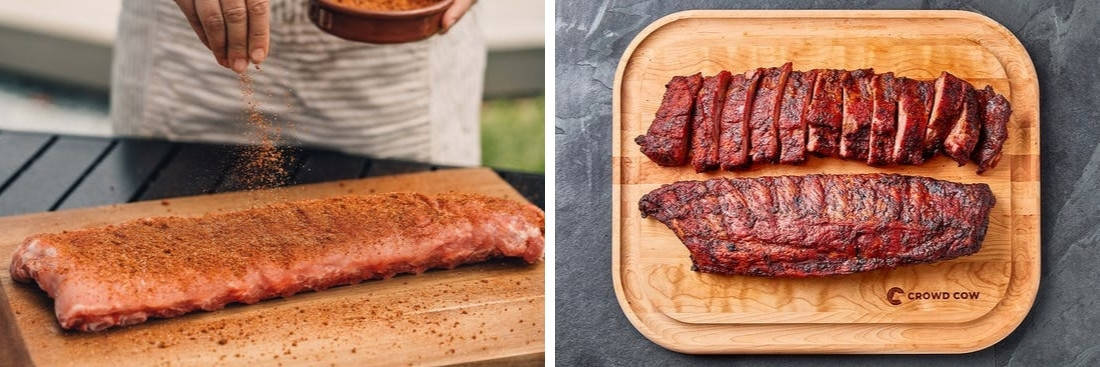
Crowd Cow sells three varieties of St Louis cut ribs: All-natural (hormone and antibiotic-free) from Pedersons natural farms; Heritage breed Berkshire Kurobota from True Story Foods; Pasture-raised from Gunthorp Farm.
They have racks weighing between 1.5 and 3.5lbs, and even sell some pre-smoked that you only need to reheat in your oven for 25 minutes (after defrosting.)
Check Price on Crowd Cow
Three Excellent Smoker Recipes for Spare or St. Louis Ribs from Around the Web
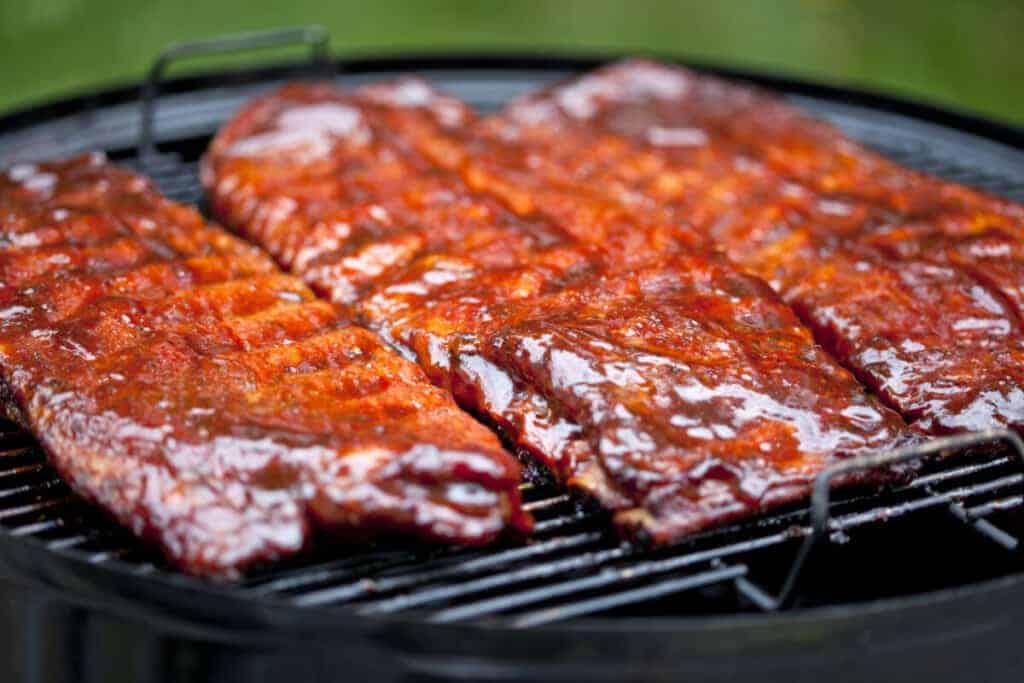
Got your ribs ready but not sure how you want them done? Here are three fantastic recipes for spare ribs you're going to love.
Sweet Honey Lime Smoked Ribs
If you like your ribs on the sweet and tangy side, this is a recipe you need to try. Limes feature prominently in the rub and the sauce. There's also a sizable dollop of honey for that sticky-sweet finish so many people love. Don't worry if you like your seasonings, though; classic rub spices like cumin and paprika are also on the ingredients list.
Cherry or applewood is recommended for this recipe. That makes sense; the sweet smoke from the fruit wood will complement the sauce beautifully. You'll need to apply sauce about a half-a-dozen times during the smoking, so if you were looking for a stick-them-in-and-walk-away recipe, this isn't it. But, the end results will be worth the effort!
Stuck on this one? Follow the link and have at it: Honey lime smoked ribs recipe.
Mesquite Smoked BBQ Pork Ribs
We couldn't resist including this classically styled recipe — there's something about mesquite we can't say no to! What's great about this recipe is you get a complex flavor, but it's simple to make; this is a beginner-level creation.
Because you use pre-made BBQ sauce instead of making your own, you'll not only save prep time, but you'll also know exactly what it tastes like before you cook. No serving up an experiment!
The rub is packed with traditional spices, including smoked paprika and cumin. It also features ancho chili powder instead of regular chili powder; ancho delivers tons of distinct flavor, but with only a tiny bit of heat.
Intrigued by traditional with a twist? Got a sauce you love already in mind? Point, click, drool: Mesquite smoked BBQ pork ribs recipe.
Smoked Mustard Crust Spare Ribs
A tasty crust of grainy mustard is something normally associated with pork shoulders. But, why shouldn't ribs get the same special treatment? You can use any mustard you choose, but the recipe calls for spicy brown. If you're worried about excessive spice, don't be — there's a bit of honey to sweeten things up.
Hickory smoke complements the zesty crust, and there's an option to mix up your own honey mustard dipping sauce. This recipe is perfect for anyone who's been scrolling through spare rib recipes, thinking, "been there, done that."
Ready to put a little mustard on it? Here comes the flavor: Smoked mustard crust ribs recipe.
There's Little More to Say
Far be it for us to keep talking when we've said all there is to say. Since St. Louis ribs are stripped down spares, they've got basically identical nutritional information, and they prep and cook about the same. You can even use the same recipes.
'Nuff said.
Final Thoughts
And there you have it — one of life's great mysteries unraveled. You can't miss with either style of ribs, and there are good reasons to choose either. Really, it's not a matter of which one. It's more like which one first?
Thanks for choosing us to answer your rib-related questions — and if you're still looking for answers, check out the rest of the site, or send your query directly to us. And if you know someone else seeking grilling knowledge, share what you've found over social or email.
Rib on, friends!
Source: https://www.foodfirefriends.com/spare-ribs-vs-st-louis-style-ribs/